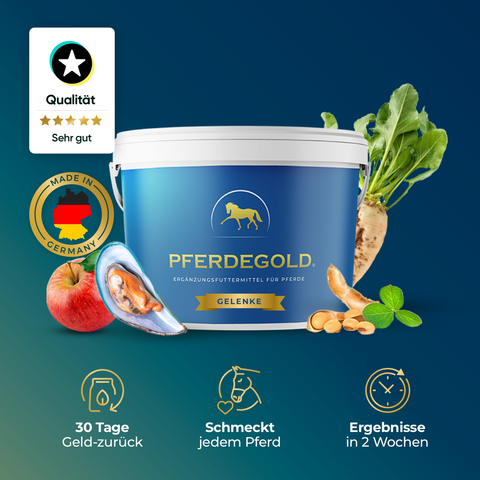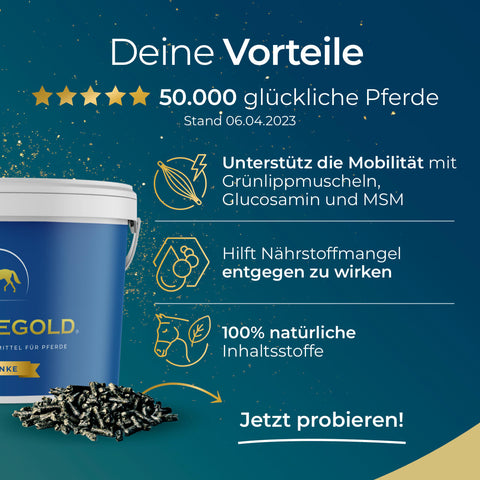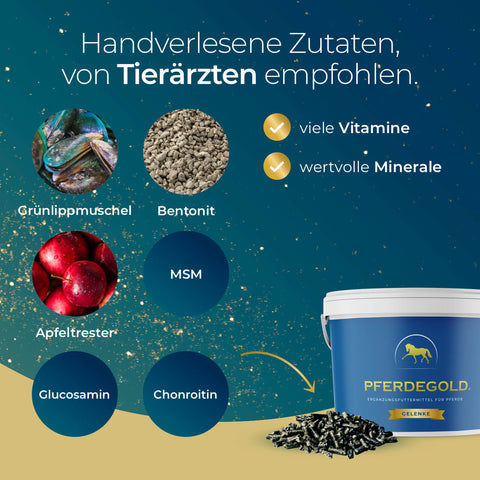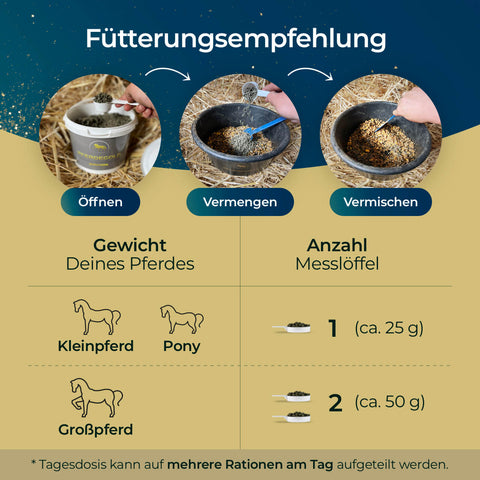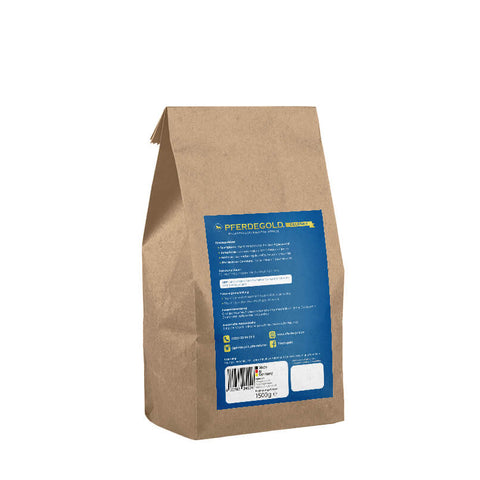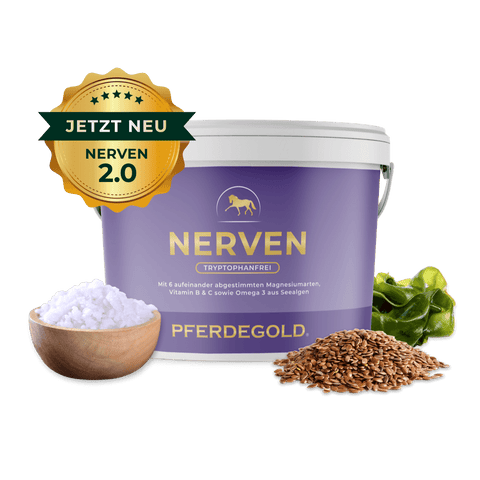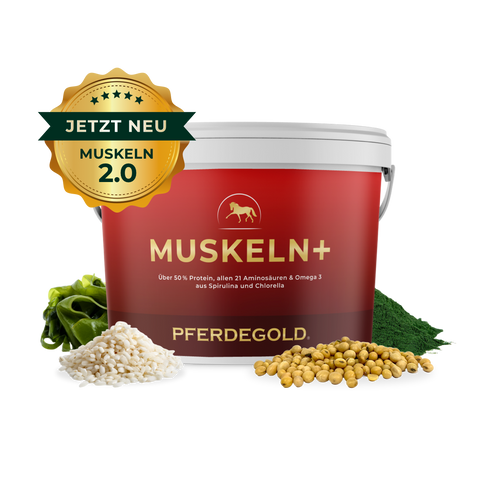joints
- Supports mobility with Omega 3
- Natural joint nutrition for all ages
- promotes the joy of movement
• Small horse/pony (up to 600 kg): 1 measuring spoon once daily
• Large horse (from 600 kg): 1 x daily 2 measuring spoons
• Simply add the pellets to the food.
Continuous feeding
Ingredients:
Soybean meal (non-GMO), green-lipped mussel, MSM, glucosamine, apple pomace, beet syrup (less than 3%), chondroitin
• No industrial sugar
• Without genetic engineering
• Grain-free
Very good tolerability due to pure and researched ingredients.
• Suitable for EMS
• Suitable for deer
• Suitable for Cushing
Doping-free! The pellets can be fed before and during a tournament.
Contents:
1.5 kg = 30 servings = 1 month of use
Notes:
• Regular and long-term intake is safe if the feeding recommendation is followed.
• No known side effects
• If you have any concerns or known allergies, please contact a trusted veterinarian.
Free gifts
Great high-quality gifts depending on the delivery class.

Collect exclusive cashback points
You will receive cashback points that you can redeem on your next order.
Learn more about subscription benefits
- 20% discount and free delivery
- Flexible savings plan (can be canceled at any time)
- 30-day money-back guarantee
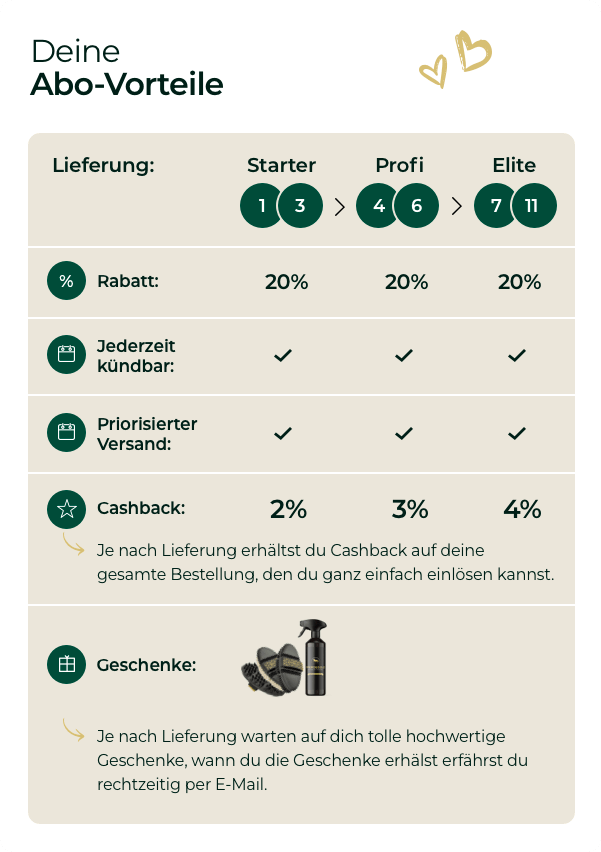
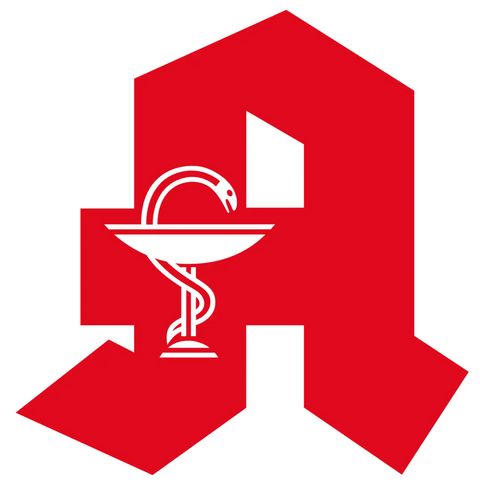
Also available in your pharmacy
You can also purchase Pferdegold at your local pharmacy. If your pharmacist doesn't have the products in stock, they can be delivered to your pharmacy within a few hours.
Pharmaceutical Central Number - 17613557
Horse joints
Horse joints
The mobility and health of the joints are crucial factors for the quality of life and performance of our horses.
Unfortunately, many horses are affected by joint problems thatdifferent formsWe would therefore like to offer you adetailed overview of the various aspectsjoint health in horses.
From the basic causes that can lead to joint problems to the recognition offirst symptoms to comprehensive treatment options– our goal isPractical advice for horse ownersOur focus is always on keeping the best for your horse in mind byWell-being of your horseat the center at all times.
What are the health consequences of joint problems?
Joint problems in horses can lead to a number of serious health consequences that extend far beyond theimmediate painand thelimited mobilityThey not only affect the horse’s ability to run and play, but can also lead tochronic pain conditionslead to along-term drug treatmentmake it necessary.
In the long term, such problems can significantly reduce the horse’s quality of life and joy of life,Behavioral changesand in severe cases even theShorten lifespan.Therefore, it isAs a horse owner, it is crucial to take preventive measures early onand at the first signs of joint diseaseexpert advice and help from a veterinarianto take advantage of.
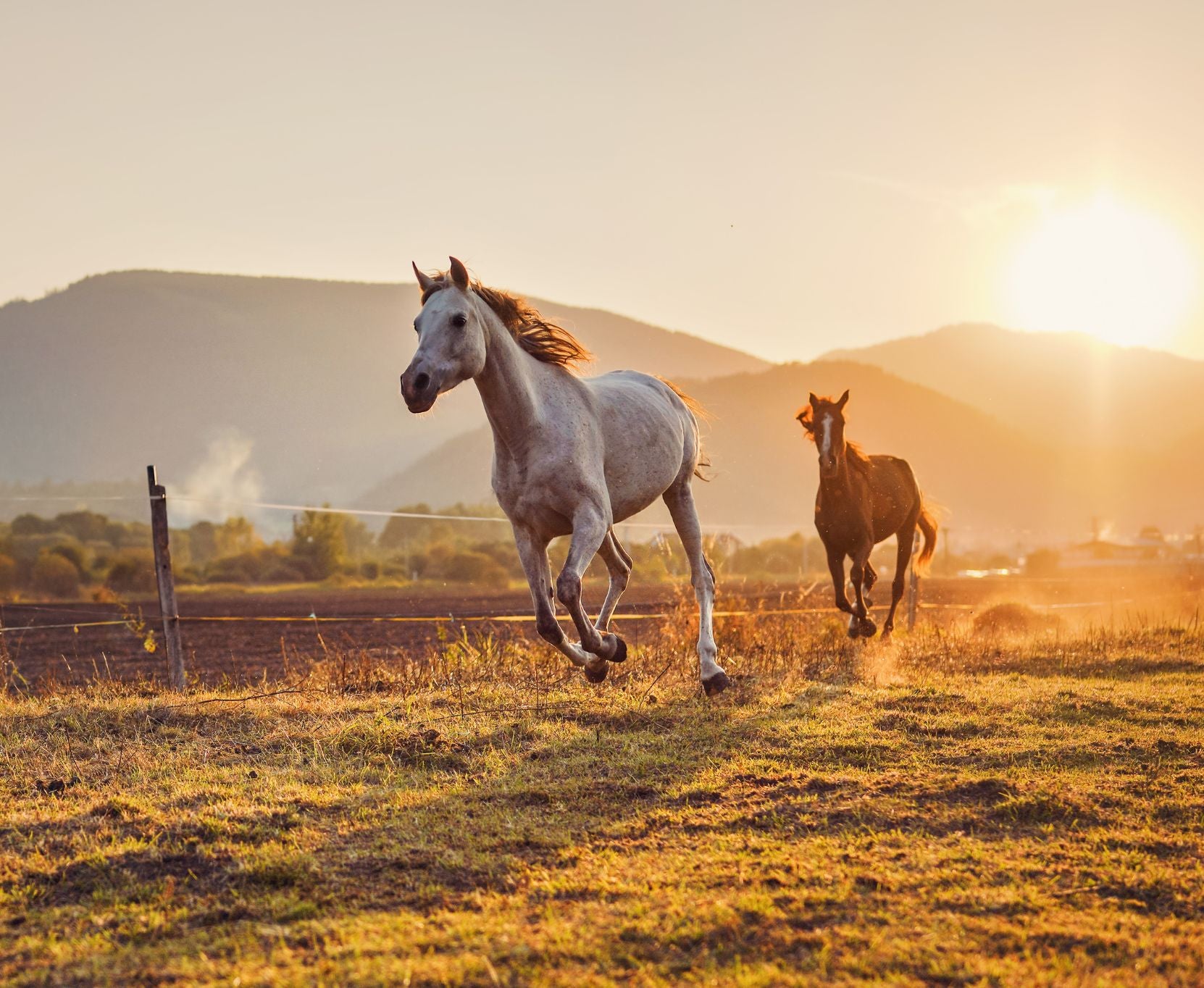
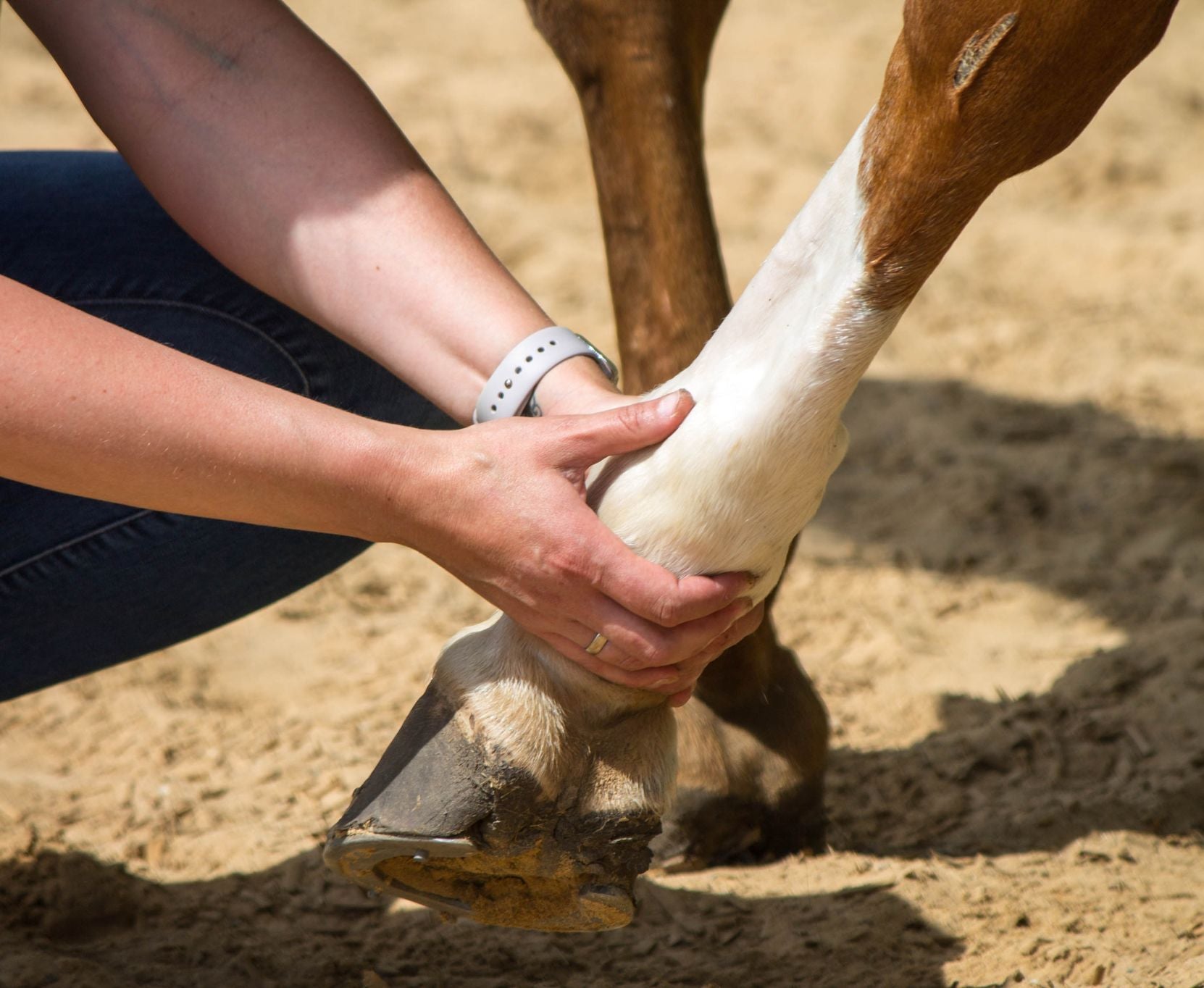
These are the benefits of joint feed for your horse’s joints
Supporting your horse with joint feed can offer a number of benefits that are aimed atSupply of essential nutrientsaim.
Adequate nutrient intake can help to close any nutrient gaps, which is important forMaintaining and promoting vitalityof a horse is essential.
The specially formulated ingredients in joint feed for horses canSupport well-being and mobility,by providing optimal nutrient supply for the joints, tendons and ligaments.
This in turn canPromote the joy of movement and an improved quality of life.The targeted nutrient supply for horses can have a positive effect on theActivity and mobilityby providing nutrients that are essential for thehealthy joint functioncan be useful.
Joint problems in horses: Everything you need to know!
Joint pain in horses is a widespread problem that can significantly impair the mobility and quality of life of our four-legged friends. The causes of such pain are diverse and range from natural wear and tear of the joints to acute injuries.
✘ Natural wear and tear
As horses age, their joints undergo natural wear and tear, which can be exacerbated by regular training or competition. As the cartilage in the joints thins, its ability to act as a shock absorber diminishes, leading to increased friction between the bones. This friction can further wear away the articular cartilage, causing inflammation and ultimately leading to osteoarthritis. Pain and stiffness are the direct result, as the natural gliding ability of the joints is impaired and mobility decreases.
✘ Injuries and overuse
Acute injuries and overuse are common causes of joint problems in horses. Activities such as jumping and rapid changes of direction, or running on uneven surfaces, can increase the risk of sprains, strains, and other injuries. Such events place direct stress on the joints, promoting inflammation and damage to the surrounding tissue. In some cases, this damage can lead to long-term impairment of joint function, with the affected areas often becoming painful and less mobile.
✘ Inflammatory diseases
Inflammatory diseases such as arthritis pose a significant challenge to the joint health of horses. Causes of this inflammation range from bacterial infections to autoimmune reactions to the consequences of injury. These conditions typically cause pain, lead to visible swelling, and significantly limit the mobility of the affected joints. In the long term, they can lead to progressive deterioration of joint function, requiring specific management and treatment approaches.
✘ Malpositions and genetic predisposition
Limb misalignments and certain predispositions can play a role in the development of joint problems in horses. These structural abnormalities in the joint structure lead to uneven loading and stress on the joints, which can accelerate the natural wear and tear process. Over time, this can lead to an increased susceptibility to joint diseases. Early detection and appropriate management strategies, such as those provided by a farrier, are crucial to minimize the progression of such conditions and maintain the horse's well-being.
Supplementary feed for horse joints: Which ingredients are essential?
Adequate nutrient supply and closing nutrient gaps can be important for supporting horses with joint problems.
There are several components that can play a role in the horse's well-being and enjoyment of movement.
- Glucosamine:An amino sugar and natural building block of cartilage. Glucosamine is found in cartilage tissue and is important for tissue formation and repair. It is also required for the production of glycosaminoglycans. Glycosaminoglycans are long chains of sugar building blocks that are essential for the structure and fluid retention of articular cartilage.
- Chondroitin sulfate:It is a complex carbohydrate (polysaccharide), meaning it contains multiple sugars. Chondroitin sulfate plays an important role in cartilage because it binds water and can thus contribute to the elasticity and shock absorption of cartilage. It is an ingredient in many horse feed supplements aimed at supporting joint health.
- Hyaluronic acid:Another polysaccharide that occurs naturally in synovial fluid and is responsible for its viscous properties. This viscosity means that hyaluronic acid has a lubricating effect. Due to its ability to bind large amounts of water, hyaluronic acid can also help keep joints well hydrated and synovial fluid at an optimal consistency.
- Omega-3 fatty acids:Can be obtained from fish oil or vegetable oils such as linseed oil. These polyunsaturated fatty acids are widely known for their anti-inflammatory properties and also contribute to the maintenance of cell membranes.
- MSM (methylsulfonylmethane):A sulfur compound that occurs naturally in many foods and is involved in the formation of collagen and keratin in the body. It supports connective tissue.
- Antioxidants (vitamin E, selenium):They can protect cells from oxidative stress. Vitamin E is obtained from vegetable oils, while selenium is an essential trace element found in nuts, meat, and seafood.
- Green-lipped mussel:The green-lipped mussel is a natural source of glycosaminoglycans, which act similarly to glucosamine and chondroitin sulfate. This mussel species, which is primarily found in New Zealand's waters, also contains omega-3 fatty acids.
Preventing joint diseases in horses: What measures help?
Preventing joint diseases in horses requires a comprehensive understanding of the animal's health needs.
A combination of a balanced diet, regular and appropriate exercise, and early detection and treatment of the first signs of joint problems can play a crucial role.
- Balanced diet:A diet rich in essential nutrients, vitamins, and minerals can have a direct impact on the horse's health, including its joints. Ingredients containing natural anti-inflammatories and building blocks for joint development, such as omega-3 fatty acids and glycosaminoglycans, can be important.
- Regular exercise:Constant, adapted movement not only helps strengthen the joints and surrounding muscles, but also promotes the production of synovial fluid, which is essential for the lubrication of the joints.
- Weight management:Maintaining an optimal weight is crucial to protecting joints from excessive stress. Being overweight increases pressure on joints, which can increase the risk of joint disease.
- Regular veterinary examinations:Regular checkups allow early detection and treatment of signs of joint problems. Early diagnosis can significantly improve the prognosis for horses with joint problems.
- Adapting your training:The training routine should be tailored to the horse's age, fitness level, and any health limitations. Overly intense or unsuitable exercises can place unnecessary strain on the joints.
Conclusion
The health of horses' joints is a crucial factor for their well-being and performance.
It is important to look for warning signs such as lameness or changes in posture early on and to conduct regular veterinary examinations in order to detect and treat joint problems in a timely manner.
A balanced diet and, if necessary, the inclusion of quality supplementary feed to provide nutritional support for the joints can also make a valuable contribution.
We at Pferdegold hope that these insights into joint problems can help you understand the importance of joint health in horses and give you the opportunity to take effective measures to support your horse.
8 reasons why you will love horse gold

Affordable
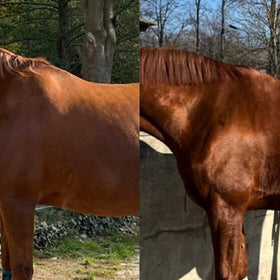
Really helps
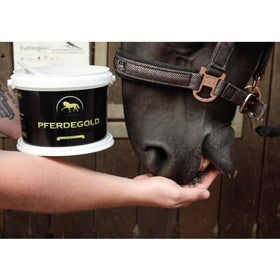
Tastes

Fast results
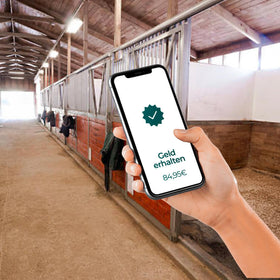
Money-back guarantee
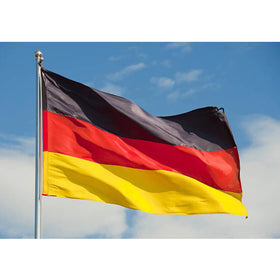
Made in Germany
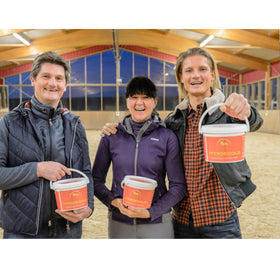
Family Business

Promise
Get Horse Gold now with a Gold subscription!
Delivered to your home every 30 days.
Full flexibility
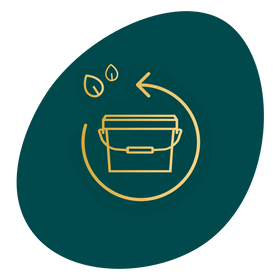
Free Shipping
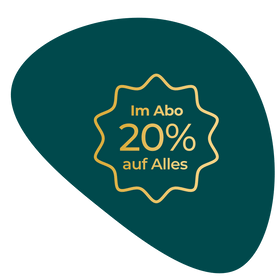
Huge savings
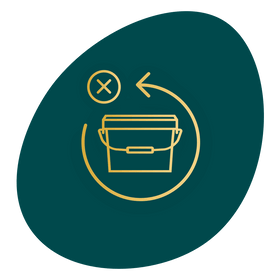
No risk
Entdecke unsere Kundenstories
questions and answers
A healthy horse is dynamic, full of vitality, and brimming with energy—an absolute dream for any horse lover. If this vitality and joy of movement suddenly disappear, it is often a sign of health problems. Symptoms such as lameness and a lack of movement indicate joint problems. To prevent such problems, species-appropriate housing, coordinated training, and proper nutrition are crucial. Nutrient deficiencies, in particular, can often trigger pain in joints, tendons, and ligaments and severely impair freedom of movement.
With regular and proper use, the first visible results will appear after approximately 2-4 weeks.
Pferdegold should be fed daily for at least 12 weeks. For optimal nutrition, we recommend feeding it year-round.
• Small horses and ponies (up to 600 kg) receive one measuring spoon of pellets once a day.
• Large horses (over 600 kg) receive two scoops of pellets once daily. Simply add the pellets to the feed.
Other products
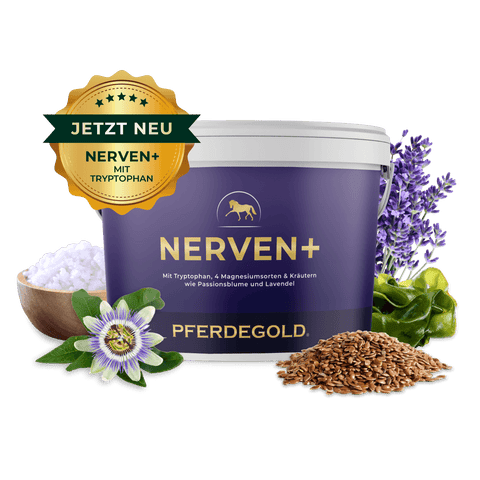
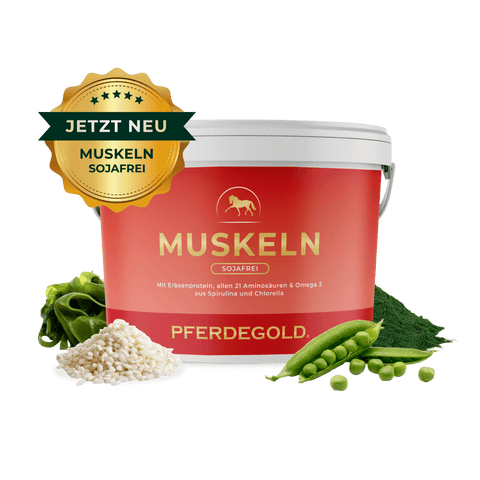
For a carefree horse life.
Do you already know our 20% savings plan?
- 20% discount on all products.
- Regular delivery according to your desired date .
- can be terminated or changed at any time.
123 John Doe Street
Your Town, YT 12345
Store Hours
Sun: Closed
Mon-Fri: 9:00 - 17:00
Sat: 10:00 - 13:00
What to expect at pickup
Closed
Closing at 5pm
Closing at 5pm
Closing at 5pm
Closing at 5pm
Closing at 5pm
Closing at 1pm
